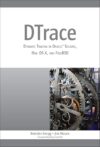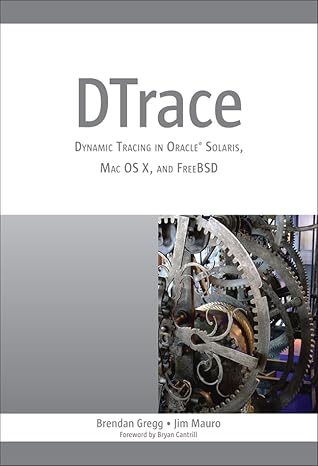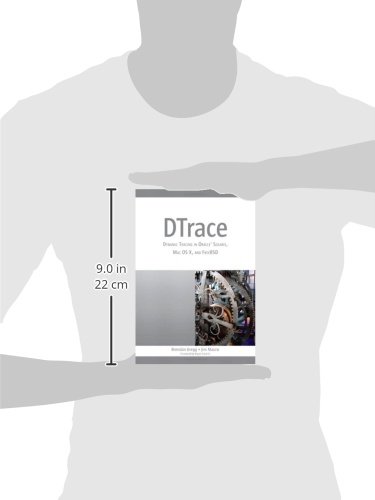DTrace: Dynamic Tracing In Oracle Solaris, Mac OS X And FreeBSD By Brendan Gregg

€16.00
DTrace: Dynamic Tracing In Oracle Solaris, Mac OS X And FreeBSD By Brendan Gregg Price comparison
DTrace: Dynamic Tracing In Oracle Solaris, Mac OS X And FreeBSD By Brendan Gregg Price History
DTrace: Dynamic Tracing In Oracle Solaris, Mac OS X And FreeBSD By Brendan Gregg Description
DTrace: Dynamic Tracing In Oracle Solaris, Mac OS X And FreeBSD By Brendan Gregg
Discover the groundbreaking insights of DTrace: Dynamic Tracing In Oracle Solaris, Mac OS X And FreeBSD by Brendan Gregg, a must-have for system administrators, developers, and performance engineers. This comprehensive guide dives deep into dynamic tracing, offering practical application in real-world scenarios on popular operating systems. Enhance your troubleshooting skills and optimize system performance with this essential resource.
Key Features and Benefits of DTrace
- In-depth Coverage: With 1115 pages of detailed content, this book provides unparalleled depth into DTrace, making it an indispensable guide for both beginners and experts.
- Expert Author: Written by Brendan Gregg, a renowned performance expert, the book leverages his extensive experience to offer proven strategies for system performance improvement.
- Practical Examples: The book is filled with hands-on exercises and case studies, allowing readers to apply the concepts to real environments immediately.
- Comprehensive Topics: Covering everything from basic DTrace usage to complex performance diagnostics, the book serves as both an instructional guide and a reference manual.
- Multiple OS Compatibility: Ideal for users of Oracle Solaris, Mac OS X, and FreeBSD, ensuring a wide applicability across diverse systems.
- ISBN Information: This first edition was published by Prentice Hall on January 1, 2012. Its ISBN-10 is 0132091518, and ISBN-13 is 978-0132091510.
Price Comparison Across Suppliers
The DTrace: Dynamic Tracing book is available at various online retailers. As you shop around, you’ll find competitive prices that fluctuate between different suppliers. Our price comparison tool equips you with the essential information needed to identify the best deal. Currently, the price ranges around $45 – $60 depending on the retailer, size, and condition (new or used).
6-Month Price History Trends
Our 6-month price history chart indicates a slight downward trend in the book’s average price, which may reflect increased availability or discounts from suppliers. Notably, prices have dipped as low as $42 during peak sale times. Keeping an eye on trends can yield great savings, especially during holiday sales or special promotions.
Customer Reviews: Insights from Readers
Customer feedback on DTrace: Dynamic Tracing reveals a wealth of knowledge and practical techniques the book offers. Many users praise its clarity and depth, making complex topics accessible. Specific positive remarks highlight:
- Clear examples that help bridge theory and practical application.
- Detailed explanations that empower even novice users to troubleshoot effectively.
- Comprehensive coverage that appeals to those seeking to enhance their understanding of dynamic tracing.
However, some readers have expressed concerns regarding the book’s extensive detail, suggesting that it may overwhelm those with less technical backgrounds. These reviews indicate that while the book is a powerful resource, readers should be prepared for an in-depth study.
Watch Unboxing and Review Videos
Engage further with DTrace: Dynamic Tracing by watching unboxing and review videos available on platforms like YouTube. These videos offer visual insights into the book’s format, structure, and usability, enhancing your understanding of the content before you make a purchase. Many reviewers appreciate the author’s teaching style, which can aid in your learning journey.
Explore More About DTrace
If you’re looking to deepen your knowledge of dynamic tracing and system performance, DTrace: Dynamic Tracing In Oracle Solaris, Mac OS X And FreeBSD is a substantial step in the right direction. Available in paperback, this book’s considerable weight (3 pounds) signifies the volume of information enclosed within its pages, perfectly designed for extensive study or reference.
Don’t miss out on this valuable resource! Enhance your skills, optimize performance, and gain insights into system behavior with this expert guide. Compare prices now!
DTrace: Dynamic Tracing In Oracle Solaris, Mac OS X And FreeBSD By Brendan Gregg Specification
Specification: DTrace: Dynamic Tracing In Oracle Solaris, Mac OS X And FreeBSD By Brendan Gregg
|
DTrace: Dynamic Tracing In Oracle Solaris, Mac OS X And FreeBSD By Brendan Gregg Reviews (6)
6 reviews for DTrace: Dynamic Tracing In Oracle Solaris, Mac OS X And FreeBSD By Brendan Gregg
Only logged in customers who have purchased this product may leave a review.









Darrin Johnson –
In a nutshell, it is a very good book especially once you get beyond the narcissism embedded in the forward and introduction. From my perspective this book serves three valuable purposes – as a tutorial, as a reference, and a resource for cool tips, tricks and generally making an software engineer’s life easier.
As a tutorial, this book provides one of the most cogent introductions to Dtrace I have seen including web content and prior books. The book, in a couple of chapters, provides a good overview of the purpose and architecture of Dtrace, the D language semantics to rudimentary examples including the canonical “Hello World”. As a tutorial is great for both the neophyte and seasoned engineers. The rest of the book continues tutorial delving into key subsystems (e.g. CPU, Memory, IO, low-level networking, filesystems, etc.) to language to application use of Dtrace. Each section will provide a good introduction and numerous valuable examples to the engineer interested in each respective area.
Probably the weakest aspect of this book is as a pure reference book but I don’t think that is its intent. The book includes several valuable appendices on Dtrace Tunable Variables, D Language Reference, Provider Arguments, etc. However it is likely that most engineers will tag key sections that are relevant to their particular interests/needs.
Also a book of cool tips and tricks, this books has a huge number examples, Tips and Tricks section, Tools, etc. with every engineer (system, middleware, end-user application development) benefiting from the specific examples and/or the ideas being conveyed. I would say that this is especially useful for even the engineers who may already be familiar with Dtrace but haven’t leveraged it’s capabilities to the fullest.
However on the downside this book doesn’t provide a comprehensive to non-dtrace based observability nor does it cover the limitations (e.g. data flow through network stack) and consequences of using dtrace (e.g. probe effect, etc.) at least from my review of the content. However as a resource it is very useful to both new hires and seasoned engineers and
is a complementary to the slightly dated “Solaris(tm) Performance and Tools: DTrace and MDB Techniques for Solaris 10 and OpenSolaris” book by Solaris(tm) by Richard McDougall, Jim Mauro and Brendan Gregg.
Overall a definite buy!
Keith –
The book provides detailed information and many examples. But they’re all for Solaris and, in many instances, must be ported. But the book provides sufficient information to allow you to do that if you have the source for your OS.
Christopher Cope –
Everything you really need to know about DTrace in a single book, yet with plenty of examples, source, and references to branch out from.
B. Rockwood –
Its finally here, the great masterpiece. This books completes what “Solaris Performance & Tools” started. This new book focuses entirely on DTrace and is really several books rolled into one.
Part I gives you a complete DTrace Textbook. It breaks down the language and introduces you all the foundational concepts. It is brisk and every concept has an example making it extremely accessable.
Part II is the combination of several runbooks and a collection of cookbooks. For CPU, I/O, network, etc there is the same methodical systematic approach to exposing problems that we got in “Performance & Tools” but vastly expanded. After hitting all the fundamental resources it breaks down into various programming languages, databases, applications and daemons.
The true value of this book is here in Part II. You may know that you have a certain kind of problem, and you know that DTrace can probly find it for you, but you don’t know where to start and in what order to proceed. If you do it on your own you may quickly find yourself overwhelmed and lost in the labyrinth that is the Solaris kernel. This is why the methodical approach Jim and Brendan take is so important, you really don’t need to know anything more than you need to dig into some broad problem and the text leads you down the path of elimination and analysis step-by-step.
Part III hits tools, tips, and security. Learn how to spy on users, audit activity, use Apple Instruments or DTrace in NetBeans and lots more. Chapter 13 on tools is a great way to learn about all those tools out there that you may have heard of but aren’t familiar with, or even introduce you to new toys you didn’t know existed.
But thats not all… there are 7 Appendix, including a complete language reference, error message reference, and cheat sheet.
The important thing about this book is that it will actually help you solve real-world problems. A hardworking sysadmin doesn’t have the time it takes to learn all the ins-and-outs of Solaris’s kernel and learning all of DTrace’s power can take years. The book is full of examples, I think have the page count has to be just code examples that you can actually use. This book is practical, accessible and will turn any Solaris administrator into an instant rock star.
DetlefD –
This is a must-read book if you plan to use DTrace for your needs. It not only explains the syntax and HowTo of Dtrace. It also shows many examples and – very useful – discusses the results and some background that makes it easier to understand the results of the scripts. That makes the book a real win – it’s not just an explanation of Dtrace, but also a book to understand better the tools for systems monitoring and tracing. All this is clearly a result of the experience of the two expert authors Brendan and Jim.
Jeff Benshetler –
This is a good way to get started using DTrace on Solaris or FreeBSD. (I haven’t tried the Linux version.) The book does a good job describing the overall structure of a DTrace script, including providers, probes, conditions, and actions. It also has a number of good examples, although perhaps 25% of the example no longer work because DTrace is evolving rapidly. That DTrace has rapidly evolved beyond what it was when this book was publish is the reason the book gets 4 stars instead of 5.
The book is well worth the purchase as a learning tool albeit less useful as a reference.